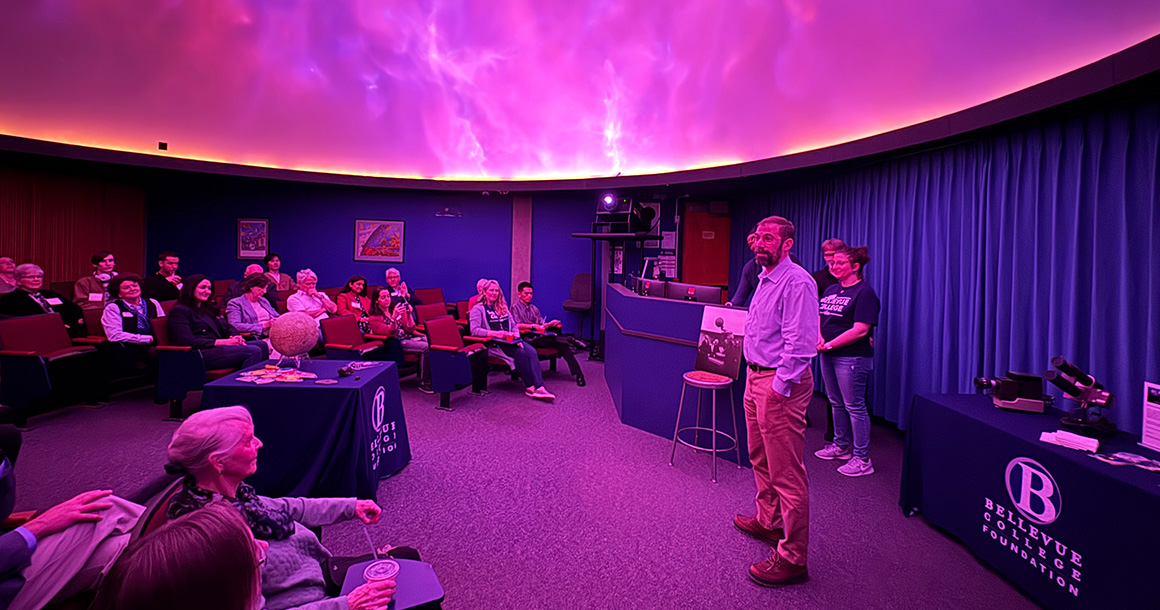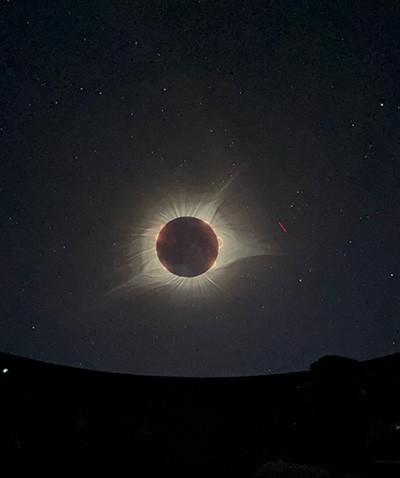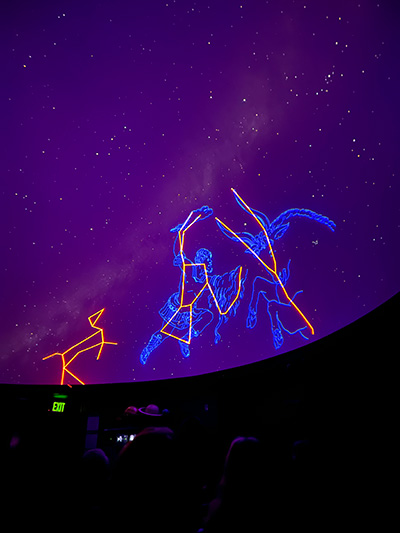Bellevue College Modernizes Planetarium Projector
Apr 21, 2025Bellevue College students and the greater community can experience digital space travel like never before with a recent upgrade to the college’s Willard Geer Planetarium.

Imagine traveling to outer space to see Earth orbiting the sun. Travel farther and you now see our solar system with stars and other planets in the distance. Continue zooming out until the Milky Way is before your eyes, Earth is but a pinprick on a fully immersive dome screen. The farther you travel through digital space, the more you realize space is huge and galaxies we can’t even fathom are light years away. But thanks to modern technology found at Bellevue College’s planetarium, you now have a front row seat.
Bellevue College students and the greater community can also experience digital space travel like never before with a recent upgrade to the college’s Willard Geer Planetarium, a building on campus with a 30-foot dome and 60 theatre-style seats for watching the stars.
Until November 2024, the planetarium had a projector system that was 16 years old and was struggling to keep up with advancing technology. After the planetarium showed its last show a year ago and had some increasingly frequent technical issues in the summer, the Astronomy department within the college’s Science Division made an appeal. It was time to replace its Digistar 3 with an Evans and Sutherland Digistar 7 projector system. With $150,000 from student fees and a $300,000 grant from the Bellevue College Foundation, the college replaced the planetarium’s hardware, including its associated computers, and the software and content library faculty use to teach astronomy classes.

“We received a state-of-the-art system that’s brought us full specs on what you would see in a world-class planetarium,” said Bellevue College astronomy instructor Joel Lamb. “It’s just a phenomenal upgrade. The projectors can project now in 4K, the backend system has capabilities of live streaming, live feeds, so we can connect directly now to domes running similar systems to see what they’re presenting. All these capabilities are live, which is a huge upgrade considering our last system kicked us off the internet because we were still running Windows XP.”
Digistar 7 allows faculty to connect to the system via an iPad so they can walk around the planetarium as they instruct their astronomy classes. The new projector also has cove mounts in the corners of the room versus a clunky center mount that took up precious classroom space.
“Our previous projectors were sitting on a pedestal in the very center of the classroom, breaking it up, making it so you couldn’t see all the students at once,” Lamb said. “You had to kind of bob and weave, ducking your head to see everyone.”
Lamb said the cove mounts make it much more welcoming and open for the overall student and community experience. Faculty can also have slides projected on the screen for lectures while showing students examples and images from space at the same time.
“I can do live demos on the dome without having to completely change the lighting of the classroom and fully dim it down,” Lamb said.
While Bellevue College isn’t the only higher education institution in Washington state with a planetarium – Pierce College, Columbia Basin College, University of Washington, and Washington State University have them, to name a few – it is unique in that it is the only college to use its planetarium as a full classroom. Other institutions only use their planetariums as classroom enhancements, according to Lamb.
“This upgrade really brings us to a point where technology is commensurate with what people are expecting when they step into a planetarium,” Lamb said. “I think the content that we have now is going to speak to the new generation a lot better than what we were able to do previously.”

Lamb hopes that the majority of people who come to Bellevue College will, at some point, be able to step inside the planetarium for a show. Whether it’s through a class, an open house, or an event, Lamb envisions the new technology reaching a larger audience and maybe even inspiring new generations to pursue STEM education.
“Upgrading our planetarium represents more than an exciting update with new, fancy equipment; it’s about bringing access back to groups, students, communities, underserved populations, and the public at large,” Lamb said. “We can now say with confidence we have a planetarium for the community.”
Now that the college has upgraded the planetarium, the next goal is to extend outreach to the K-12 school districts and outside community members. The Science and Math Institute at Bellevue College is now accepting special event requests for STEM student groups this April and May. If you are a community or education organization interested in visiting the planetarium, fill out the STEM student group community partnership interest form.
Willard Geer Planetarium History
Bellevue Community College’s planetarium was established in the late 1960s shortly after the college opened in 1966. However, the planetarium lacked an instrument to project the night sky onto the dome. Dr. C. Willard Geer, the college’s first physics instructor, created “Friends of the Planetarium” in 1972 to raise money for the star projector. After several efforts that included a letter-writing campaign, posters to school children, and securing a $200,000 grant, the projector was installed in 1974. His goal was that all school classes would be able to visit the planetarium for free. Upon Geer’s passing in 1975, the planetarium was named after him. The planetarium and STEM education would continue to be a pillar of the college in the years to come, with technological upgrades made throughout the decades. Prior to 2024, the most recent upgrade was from Digistar 2 to Digistar 3 in 2008.
